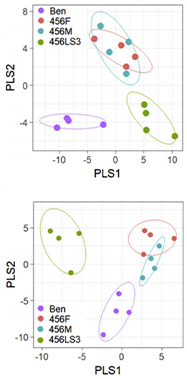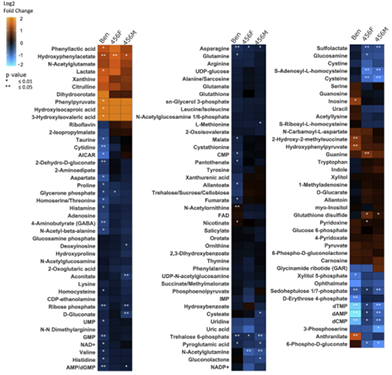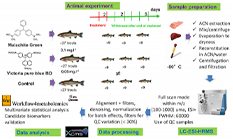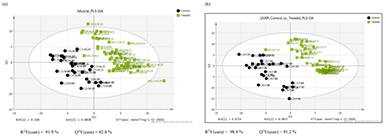
Animal Metabolomics
Journal: Cell Metabolism Impact factor: 22.415 Published date: 2019 Published by: Princeton University, the United States
Mammalian organs continuously exchange metabolites through circulation, but systematic-level studies on the mechanisms of metabolite exchange are lacking.
In this paper, we compared the concentrations of metabolites in arterial blood and venous blood of 11 organs of fasting pigs by LC-MS technology.
1) More than 90% of metabolites show arteriovenous differences in at least one organ; 2) The liver and kidney release not only glucose but also amino acids, which are mainly consumed by the gut and pancreas; 3) The liver preferentially consumes unsaturated fatty acids, while the kidneys consume circulating citrate and net oxidized lactate pyruvate, thereby contributing to circulating redox homeostasis; 4) Production or consumption of more than 700 tissue-specific metabolites was detected.
 Figure 1 Experiment process
Figure 1 Experiment process Figure 2 Glucose production is restricted to the liver and kidneys, while lactate production is distributed throughout the body
Figure 2 Glucose production is restricted to the liver and kidneys, while lactate production is distributed throughout the body Figure 3 Kidneys clear most metabolites, citrate is specific fuel for kidney
Figure 3 Kidneys clear most metabolites, citrate is specific fuel for kidney Figure 4 The liver and kidneys release amino acids, which are consumed in large quantities by other internal organs
Figure 4 The liver and kidneys release amino acids, which are consumed in large quantities by other internal organsJang Cholsoon,Hui Sheng,Zeng Xianfeng et al. Metabolite Exchange between Mammalian Organs Quantified in Pigs.[J] .Cell Metab., 2019, 30: 594-606.e3
Journal: Insect Biochemistry and Molecular Biology Impact factor: 3.827 Published date: 2019 Published by: University of Tennessee, the United States
Populations of the fall armyworm (Spodoptera frugiperda) have developed resistance to transgenic corn producing the Cry1F insecticidal protein from the bacterium Bacillus thuringiensis (Bt).
We hypothesized that Cry1F-resistant fall armyworm with a non-functional SfABCC2 protein would display altered gut metabolome composition when compared to susceptible insects. Mass spectrometry and multivariate statistical analyses identified 126 unique metabolites from larval guts, of which 7 were found to display statistically significant altered levels between midguts from susceptible and Cry1F-resistant S.
Among these 7 differentially present 36 metabolites, 6 were found to significantly accumulate (1.3 to 3.5-fold) in midguts from Cry1F-resistant larvae, including nucleosides, asparagine, and carbohydrates such as trehalose 6-phosphate and sedoheptulose 1/7-phosphate. In contrast, metabolomic comparisons of larvae fed on non-transgenic corn identified 5 metabolites with statistically significant altered levels and only 2 of them, 2-isopropylmalate and 3-phosphoserine, that significantly accumulated (2.3- and 3.5-fold, respectively) in midguts from Cry1F-resistant compared to susceptible larvae. These may have the potential to be used as resistance markers.


H. Abdelgaffar et al., Midgut metabolomic profiling of fall armyworm (Spodoptera frugiperda) with field-evolved resistance to Cry1F corn. Insect Biochem Mol Biol. 2019 Mar;106:1-9
Journal: Food Chemistry Impact factor: 6.306 Published date: 2019 Published by: French Angers Chemical Laboratory
The aim of the study was to initiate an exhaustive strategy of control by implementing both targeted and non-targeted metabolomics approaches. A LC-MS/MS method including an oxidative step for most of dyes was developed and validated to target the analysis of 14 residues belonging to different families of dyes. The metabolomics approach objective was to compare fingerprints between farmed fish treated with malachite green and farmed fish treated with victoria pure blue bo. Analytical information on modifications in the metabolome of muscle, liver and plasma was exploited by HRMS following by multivariate statistics and revealed some direct or endogenous metabolites among relevant mass features contributing to the constructed models. These two approaches, either appropriate biomarkers either enlarged targeted dyes are explored concomitantly to help improving the strategy for tracking new illegal practices in aquaculture.
 Figure 1 Experiment process
Figure 1 Experiment process
 Figure 2 PLS-DA diagram
Figure 2 PLS-DA diagram
E. Dubreil et al.,Dye residues in aquaculture products: Targeted and metabolomics mass spectrometric approaches to track their abuse. Food Chemistry 294 (2019) 355–367
 © Copyright 2015-2022 Suzhou PANOMIX Biomedical Tech Co.,Ltd
© Copyright 2015-2022 Suzhou PANOMIX Biomedical Tech Co.,Ltd